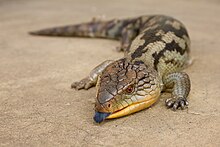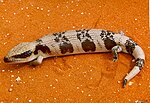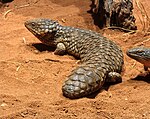Blue-tongued skink
| Blue-tongued skinks | |
|---|---|

| |
| Blotched blue-tongued skink (Tiliqua nigrolutea) | |
| Scientific classification | |
| Kingdom: | Animalia |
| Phylum: | Chordata |
| Class: | Reptilia |
| Order: | Squamata |
| Family: | Scincidae |
| Subfamily: | Egerniinae |
| Genus: | Tiliqua Gray, 1825[1] |
| Species | |
|
8, see text. | |
| Synonyms | |
|
Trachydosaurus | |
Blue-tongued skinks[2] comprise the Australasian genus Tiliqua, which contains some of the largest members of the skink family (Scincidae). They are commonly called blue-tongued lizards or simply blue-tongues or blueys in Australia. As suggested by these common names, a prominent characteristic of the genus is a large blue tongue that can be bared as a bluff-warning to potential enemies. The tongue can also deform itself and produce a thick mucus in order to catch prey. They are relatively shy in comparison with other lizards, and also significantly slower due to their short legs.
Systematics and distribution[]
Blue-tongued skinks are closely related to the genera Cyclodomorphus and Hemisphaeriodon. All species are found on mainland Australia with the exception of Tiliqua gigas, which occurs in New Guinea and various islands of Indonesia. One subspecies of Tiliqua scincoides is also found on several small Indonesian islands between Australia and New Guinea. Tiliqua nigrolutea is the only species present in Tasmania. With the exception of the pygmy blue-tongue, they are relatively large lizards (up to 45 cm total length), light-bodied, short-limbed, broad with distinct heads and dull teeth.
Ecology[]
Most species are diurnal, ground-foraging omnivores, feeding on a wide variety of insects, gastropods, flowers, fruits and berries.[3] The pygmy blue-tongue is again the exception, being primarily an ambush predator of terrestrial arthropods.[4] All are viviparous, with litter sizes ranging from 1-4 in the pygmy blue-tongue and shingleback to 5-24 in the eastern and northern blue-tongues.[5]
Species[]
| Name | Scientific Name | Picture | Subspecies |
|---|---|---|---|
| Adelaide pygmy blue-tongue skink | T. adelaidensis (Peters, 1863) | ||
| Indonesian blue-tongued skink | T. gigas (Schneider, 1801) | 
|
T. g. gigas, Giant blue-tongued skink; T. g. evanescens, Merauke blue-tongued skink; T. g. keyensis, Key Island blue-tongued skink |
| Centralian blue-tongued skink | T. multifasciata (Sternfeld, 1919) | 
|
|
| Blotched blue-tongued skink | T. nigrolutea (Quoy & Gaimard, 1824) | 
|
|
| Western blue-tongued skink | T. occipitalis (Peters, 1863) | 
|
|
| Shingleback | T. rugosa (Gray, 1825) | 
|
T. r. aspera, Eastern shingleback; T. r. konowi, Rottnest Island shingleback; T. r. palarra, Shark Bay shingleback; T. r. rugosa, Common shingleback |
| Common blue-tongued skink | T. scincoides (White, 1790) | 
|
T. s. chimaerea, ; T. s. intermedia, Northern blue-tongued skink; T. s. scincoides, Eastern blue-tongued skink |
| Irian Jaya blue-tongued skink | Tiliqua sp. | 
|
Notes[]
- ^ Gray, J.E. (1825). A synopsis of the genera of reptiles and Amphibia, with a description of some new species. Annals of Philosophy 10:193—217. p. 201
- ^ Tiliqua, Reptile Database
- ^ Cogger, H.G. (2000). Reptiles and Amphibians of Australia. Reed New Holland.
- ^ Department for Environment and Heritage > Pygmy Bluetongue Lizard - fact sheet Retrieved 18 July 2017
- ^ Turner, G. 2001. Keeping Bluetongue Lizards. Australian Reptile Keeper Publications.
References[]
- Austin, J.J. & Arnold, E.N. (2006). Using ancient and recent DNA to explore relationships of extinct and endangered Leiolopisma skinks (Reptilia: Scincidae) in the Mascarene islands. Molecular Phylogenetics and Evolution 39(2): 503–511. doi:10.1016/j.ympev.2005.12.011 (HTML abstract)
- Bull, C.M. (1988). Mate fidelity in an Australian lizard Trachydosaurus rugosus (Scincidae). Copeia 1987(3): 749-757.
- Bull, C.M. (1990). Comparison of displaced and retained partners in a monogamous lizard Tiliqua rugosa. 17: 135-140.
- Valentic, R.A. (1996). A prey record of the Eastern Blue-tongue Tiliqua scincoides for the common brown snake Pseudonaja textilis. Monitor 8(3): 155.
External links[]
| Wikimedia Commons has media related to Tiliqua. |
| Wikispecies has information related to Tiliqua. |
- Skinks of Australia
- Reptiles of Indonesia
- Reptiles of New Guinea
- Tiliqua
- Scavengers
- Taxa named by John Edward Gray
- Reptiles as pets